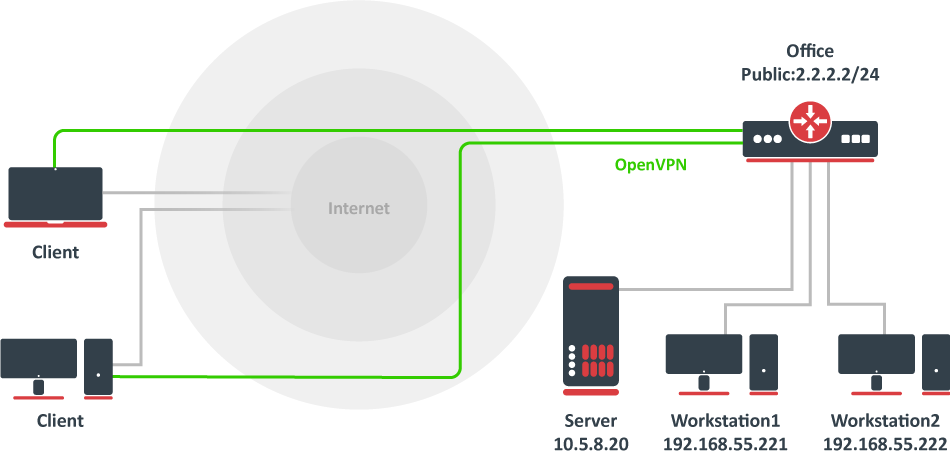Overview
The OpenVPN security model is based on SSL, the industry standard for secure communications via the internet. OpenVPN implements OSI layer 2 or 3 secure network extensions using the SSL/TLS protocol.
Introduction
OpenVPN has been ported to various platforms, including Linux and Windows, and its configuration is likewise on each of these systems, so it makes it easier to support and maintain. OpenVPN can run over User Datagram Protocol (UDP) or Transmission Control Protocol (TCP) transports, multiplexing created SSL tunnels on a single TCP/UDP port. OpenVPN is one of the few VPN protocols that can make use of a proxy, which might be handy sometimes.
Limitations
Currently, unsupported OpenVPN features:
- LZO compression
- TLS authentication
- authentication without username/password
OVPN Client
OVPN Server
An interface is created for each tunnel established to the given server. There are two types of interfaces in OVPN server's configuration
- Static interfaces are added administratively if there is a need to reference the particular interface name (in firewall rules or elsewhere) created for the particular user.
- Dynamic interfaces are added to this list automatically whenever a user is connected and its username does not match any existing static entry (or in case the entry is active already, as there can not be two separate tunnel interfaces referenced by the same name).
Dynamic interfaces appear when a user connects and disappear once the user disconnects, so it is impossible to reference the tunnel created for that use in router configuration (for example, in firewall), so if you need a persistent rule for that user, create a static entry for him/her. Otherwise it is safe to use dynamic configuration.
In both cases PPP users must be configured properly - static entries do not replace PPP configuration.
Properties
| Property | Description |
|---|---|
| auth (sha1 | md5; Default: sha1,md5) | Authentication methods that server will accept. |
| certificate (name | none; Default: none) | Name of the certificate that OVPN server will use. |
| cipher (aes128 | aes192 | aes256 | blowfish128; Default: aes128,blowfish128) | Allowed ciphers. |
| default-profile (name; Default: default) | Default profile to use. |
| enabled (yes | no; Default: no) | Defines whether OVPN server is enabled or not. |
| keepalive-timeout (integer | disabled; Default: 60) | Defines the time period (in seconds) after which the router is starting to send keepalive packets every second. If no traffic and no keepalive responses has came for that period of time (i.e. 2 * keepalive-timeout), not responding client is proclaimed disconnected |
| mac-address (MAC; Default: ) | Auto Generated MAC address of the server. |
| max-mtu (integer; Default: 1500) | Maximum Transmission Unit. Max packet size that OVPN interface will be able to send without packet fragmentation. |
| mode (ip | ethernet; Default: ip) | Layer3 or layer2 tunnel mode (alternatively tun, tap) |
| netmask (integer; Default: 24) | Subnet mask to be applied to client. |
| port (integer; Default: 1194) | Port to run server on. |
| require-client-certificate (yes | no; Default: no) | If set to yes, then server checks whether client's certificate belongs to the same certificate chain. |
It is very important that the date on the router is within the range of the installed certificate's date of expiration. To overcome any certificate verification problems, enable NTP date synchronization on both server and client.
Example
Setup Overview
Assume that Office public IP address is 2.2.2.2 and we want two remote OVPN clients to have access to 10.5.8.20 and 192.168.55.0/24 networks behind office gateway.
Creating Certificates
All certificates can be created on RouterOS server using certificate manager. See example >>.
For simplest setup you need only ovpn server certificate.
Server Config
First step is to create ip pool from which client addresses will be assigned and some users.
/ip pool add name=ovpn-pool range=192.168.77.2-192.168.77.254 /ppp profile add name=ovpn local-address=192.168.77.1 remote-address=ovpn-pool /ppp secret add name=client1 password=123 profile=ovpn add name=client2 password=234 profile=ovpn
Assume that server certificate is already created and named "server"
/interface ovpn-server server set enabled=yes certificate=server
Client Config
Since RouterOS does not support route-push you need to add manually which networks you want to access over the tunnel.
/interface ovpn-client add name=ovpn-client1 connect-to=2.2.2.2 user=client1 password=123 disabled=no /ip route add dst-address=10.5.8.20 gateway=ovpn-client1 add dst-address=192.168.55.0/24 gateway=ovpn-client1 /ip firewall nat add chain=srcnat action=masquerade out-interface=ovpn-client1
